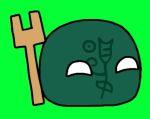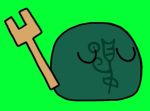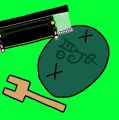Xia Dynasty: Difference between revisions
(→歷史(History): Don’t use Chinese brackets for English text) |
|||
| Line 35: | Line 35: | ||
The national color of Xia is grue-black and his element is water. The major innovation of Xia was the bronze caldron [鑄鼎] (unfortunately, it is currently archaeologically undiscovered). | The national color of Xia is grue-black and his element is water. The major innovation of Xia was the bronze caldron [鑄鼎] (unfortunately, it is currently archaeologically undiscovered). | ||
== | == 歷史 (History) == | ||
=== 开國 (Beginnings) === | === 开國 (Beginnings) === | ||
The Xia Dynasty was founded after [[File:Xia-icon.png]] [[Monarchism|Yu the Great]], after 13 years of nonstop work, channeled all the flood water out of China after a giant flood. [[File:Xia-icon.png]] [[Monarchism|Yu the Great]] became the first ruler of the newly founded Xia Dynasty, and the people were happy. [[File:Xia-icon.png]] [[Monarchism|Yu the Great]]'s leadership and engineering prowess not only secured his place as the first ruler of the Xia Dynasty but also set a precedent for future governance and societal organization. His success in flood control demonstrated the importance of strong, centralized authority and infrastructure development, laying the groundwork for the stability and prosperity of the Xia Dynasty. | The Xia Dynasty was founded after [[File:Xia-icon.png]] [[Monarchism|Yu the Great]], after 13 years of nonstop work, channeled all the flood water out of China after a giant flood. [[File:Xia-icon.png]] [[Monarchism|Yu the Great]] became the first ruler of the newly founded Xia Dynasty, and the people were happy. [[File:Xia-icon.png]] [[Monarchism|Yu the Great]]'s leadership and engineering prowess not only secured his place as the first ruler of the Xia Dynasty but also set a precedent for future governance and societal organization. His success in flood control demonstrated the importance of strong, centralized authority and infrastructure development, laying the groundwork for the stability and prosperity of the Xia Dynasty. | ||
Revision as of 04:00, 28 July 2024
“
於!帝念哉!德惟善政,政在養民。水、火、金、木、土、穀,惟修;正德、利用、厚生、惟和。九功惟敘,九敘惟歌。戒之用休,董之用威,勸之以九歌俾勿壞。[1]
— ![]() Yu the Great
Yu the Great
The Xia Dynasty, sometimes spelled the Hsia Dynasty, is the first dynasty in ![]() Chinese history. It is uncertain exactly when he existed, but legends say he was founded after a great flood. Due to the lack of direct evidence of Xia’s existence, some scholars debate that the Xia Dynasty was completely fictional.
Chinese history. It is uncertain exactly when he existed, but legends say he was founded after a great flood. Due to the lack of direct evidence of Xia’s existence, some scholars debate that the Xia Dynasty was completely fictional.
The national color of Xia is grue-black and his element is water. The major innovation of Xia was the bronze caldron [鑄鼎] (unfortunately, it is currently archaeologically undiscovered).
歷史 (History)
开國 (Beginnings)
The Xia Dynasty was founded after ![]() Yu the Great, after 13 years of nonstop work, channeled all the flood water out of China after a giant flood.
Yu the Great, after 13 years of nonstop work, channeled all the flood water out of China after a giant flood. ![]() Yu the Great became the first ruler of the newly founded Xia Dynasty, and the people were happy.
Yu the Great became the first ruler of the newly founded Xia Dynasty, and the people were happy. ![]() Yu the Great's leadership and engineering prowess not only secured his place as the first ruler of the Xia Dynasty but also set a precedent for future governance and societal organization. His success in flood control demonstrated the importance of strong, centralized authority and infrastructure development, laying the groundwork for the stability and prosperity of the Xia Dynasty.
Yu the Great's leadership and engineering prowess not only secured his place as the first ruler of the Xia Dynasty but also set a precedent for future governance and societal organization. His success in flood control demonstrated the importance of strong, centralized authority and infrastructure development, laying the groundwork for the stability and prosperity of the Xia Dynasty.
![]() Yu the Great also divided his land into nine provinces and improved agricultural systems. The Xia Dynasty also practiced some bronze making, though not as advanced as the later dynasties. There are some pots and pans discovered that is thought to have belonged to the Xia Dynasty.
Yu the Great also divided his land into nine provinces and improved agricultural systems. The Xia Dynasty also practiced some bronze making, though not as advanced as the later dynasties. There are some pots and pans discovered that is thought to have belonged to the Xia Dynasty.
间歇期 (Interregnum)
The third Xia king, ![]() Tai Kang, was known for his avid hunting but was considered an ineffective ruler. According to the Bamboo Annals, while
Tai Kang, was known for his avid hunting but was considered an ineffective ruler. According to the Bamboo Annals, while ![]() Tai Kang was away on a hunting expedition beyond the
Tai Kang was away on a hunting expedition beyond the ![]() Henan Luo River, the Xia capital at
Henan Luo River, the Xia capital at ![]() Zhenxun was attacked by
Zhenxun was attacked by ![]() Hou Yi. This occupation of
Hou Yi. This occupation of ![]() Zhenxun marked the beginning of a significant interregnum. In the eighth year of the reign of
Zhenxun marked the beginning of a significant interregnum. In the eighth year of the reign of ![]() Tai Kang's nephew, king
Tai Kang's nephew, king ![]() Xiang,
Xiang, ![]() Hou Yi was killed by his former chief minister,
Hou Yi was killed by his former chief minister, ![]() Han Zhuo. Twenty years later,
Han Zhuo. Twenty years later, ![]() Han Zhuo's forces killed king
Han Zhuo's forces killed king ![]() Xiang and usurped the throne, although the royal family managed to escape.
Xiang and usurped the throne, although the royal family managed to escape.
![]() Xiang's son,
Xiang's son, ![]() Shao Kang, was sheltered by a tribal chief, surviving for years as a fugitive despite
Shao Kang, was sheltered by a tribal chief, surviving for years as a fugitive despite ![]() Han Zhuo's efforts to eliminate him and prevent the reemergence of the Xia Dynasty. Upon reaching adulthood,
Han Zhuo's efforts to eliminate him and prevent the reemergence of the Xia Dynasty. Upon reaching adulthood, ![]() Shao Kang began organizing with local lords who despised
Shao Kang began organizing with local lords who despised ![]() Han Zhuo's rule.
Han Zhuo's rule. ![]() Shao Kang ultimately emerged victorious in the ensuing military confrontation, leading to
Shao Kang ultimately emerged victorious in the ensuing military confrontation, leading to ![]() Han Zhuo's suicide. The reigns of
Han Zhuo's suicide. The reigns of ![]() Shao Kang and his son
Shao Kang and his son ![]() Zhu are traditionally characterized as among the most prosperous periods in the history of the Xia Dynasty.
Zhu are traditionally characterized as among the most prosperous periods in the history of the Xia Dynasty.
灭亡 (Fall)
The last king of Xia, ![]() Jie, was tyrannical and immoral. He would put people on burning pillars and make them crawl on it just to get a laugh. While the peasants were starving, he would create a pool full of wine for his friends to drink, and when people got drunk and drowned in the pool, he didn’t bat an eye. He also created forests hanging with meat (very wasteful). Natural disasters were rampant. The Xia has officially lost their Mandate of Heaven.
Jie, was tyrannical and immoral. He would put people on burning pillars and make them crawl on it just to get a laugh. While the peasants were starving, he would create a pool full of wine for his friends to drink, and when people got drunk and drowned in the pool, he didn’t bat an eye. He also created forests hanging with meat (very wasteful). Natural disasters were rampant. The Xia has officially lost their Mandate of Heaven.
A neighboring tribe, the ![]() Shang clan, saw this chaos unfold within the once so powerful Xia Empire. Their leader,
Shang clan, saw this chaos unfold within the once so powerful Xia Empire. Their leader, ![]() Cheng Tang, lead an army to invade the Xia. As the
Cheng Tang, lead an army to invade the Xia. As the ![]() Shang army stormed through the villages and palaces, they told the people that they are only here for
Shang army stormed through the villages and palaces, they told the people that they are only here for ![]() Jie. Many Xia people joined the
Jie. Many Xia people joined the ![]() Shang, and their army grew stronger and stronger.
Shang, and their army grew stronger and stronger. ![]() Jie’s forces were destroyed in a storm so
Jie’s forces were destroyed in a storm so ![]() Jie fled. The
Jie fled. The ![]() Shang Dynasty was established. King
Shang Dynasty was established. King ![]() Tang gave the remnants of the Xia clan a fief comprising the small state of
Tang gave the remnants of the Xia clan a fief comprising the small state of ![]() Qǐ. This practice is known as "the two crownings and the three respects".
Qǐ. This practice is known as "the two crownings and the three respects".
环保自然 (Environmentalism)
During the legendary reign of ![]() Yu the Great roughly four millennia ago, in the first three months of the spring, people didn’t take their axes to the forests so the trees could flourish. In the three months of the summer, people didn’t put nets to rivers so fishes could breed. This is the traditional way of moderating and conserving nature, and promotes harmony between man and earth, cherishing and protecting it while still getting all the needs.
Yu the Great roughly four millennia ago, in the first three months of the spring, people didn’t take their axes to the forests so the trees could flourish. In the three months of the summer, people didn’t put nets to rivers so fishes could breed. This is the traditional way of moderating and conserving nature, and promotes harmony between man and earth, cherishing and protecting it while still getting all the needs.
画廊 (Gallery)
-
Flooding
The Green-Screened Animation
-
They killed
Young SheldonXia Dynasty (click to view) -
happy
-
proud
-
-
-
cool hat, huh?
-
oh nah
-
THEY KILLED HIM
Notes
- ↑
 Yu said, 'Oh! think (of these things), O Di. The virtue (of the ruler) is seen in (his) good government, and that government in the nourishing of the people. There are water, fire, metal, wood, the earth, and grain - these must be duly regulated; there are the rectification of (the people's) virtue, (the tools and other things) that supply the conveniences of life, and the securing abundant means of sustentation - these must be harmoniously attended to. When the nine services (thus indicated) have been orderly accomplished, that accomplishment will be hailed by (the people's) songs. Caution them with gentle (words), correct them with the majesty (of law), stimulate them with the songs on those nine subjects - in order that (your success) may not suffer diminution.'
Yu said, 'Oh! think (of these things), O Di. The virtue (of the ruler) is seen in (his) good government, and that government in the nourishing of the people. There are water, fire, metal, wood, the earth, and grain - these must be duly regulated; there are the rectification of (the people's) virtue, (the tools and other things) that supply the conveniences of life, and the securing abundant means of sustentation - these must be harmoniously attended to. When the nine services (thus indicated) have been orderly accomplished, that accomplishment will be hailed by (the people's) songs. Caution them with gentle (words), correct them with the majesty (of law), stimulate them with the songs on those nine subjects - in order that (your success) may not suffer diminution.'









